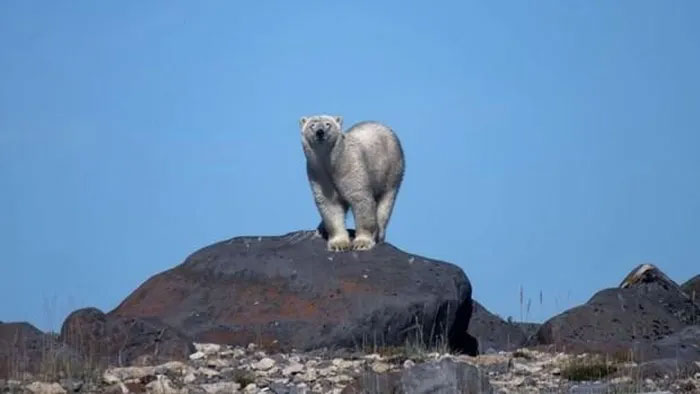Amidst a rocky terrain far from the icy sea, a solitary Canadian polar bear sits under the sun, its pristine white fur no longer providing effective camouflage.
This moment occurs in the middle of summer along Hudson Bay, marking a critical time for the survival of polar bears in the region.
Every year, from late June, as the ice in the bay melts and gradually disappears, polar bears must move inland to begin a mandatory fasting period. However, due to rising average temperatures, this fasting period is being extended.

The sea ice – habitat of the polar bear, is gradually disappearing.
Mr. Geoff York, a biologist with the nonprofit organization Polar Bear International (PBI), explains that once polar bears have migrated to land, their food options become severely limited.
According to recent studies, global warming is affecting the Arctic three times faster than other regions of the world – with some studies suggesting it could be four times faster. As a result, the sea ice – the habitat of polar bears, is gradually disappearing.
A report published two years ago in the journal Nature Climate Change indicated that this trend could push the species to the brink of extinction.
In the 1980s, Hudson Bay recorded about 1,200 polar bears, but today, scientists estimate that number has dwindled to around 800.
With each passing summer, the sea ice tends to melt faster, while new ice formation occurs later. Consequently, climate change threatens the very life cycle of polar bears, leaving them with less time to build up fat and calories before entering their summer fasting period.
The polar bear – scientifically known as Ursus maritimus – is a carnivorous species, primarily feeding on the blubber of seals that insulate their bodies. However, nowadays, these Arctic predators sometimes resort to eating seaweed.
Mr. Steve Amstrup, a scientist at PBI, states that if female bears do not have enough food for 117 days, their ability to rear their young becomes challenging, while males can fast for about 180 days.
As a result, the birth rate of polar bears is declining, and the occurrence of litters of three cubs – once common – is now becoming increasingly rare.
Mr. York notes that this is a sign of a deteriorating ecosystem. After years of monitoring and researching this species in Churchill – a small town on the northern edge of the Arctic in Manitoba, Canada – Mr. York asserts that polar bears in Hudson Bay are now fasting for about a month longer than they used to.
According to Mr. York, this change also alters the hunting habits of polar bears, as they have recently begun appearing at local garbage dumps in Churchill. While this provides an easily accessible food source, it is detrimental to the bears’ health as they may ingest waste materials like plastic, posing dangers to humans who frequently encounter these animals.
Mr. Flavio Lehner, a climate scientist at Cornell University, remarks that the increasingly “fragile” fate of polar bears serves as a warning to humanity, as the Arctic is considered a “thermometer” for the health of the Earth.
Mr. Lehner emphasizes the importance of this region for global climate, as the Arctic acts as an effective “air conditioner” for the planet.
However, according to the National Snow and Ice Data Center, since the 1980s, the amount of ice in Hudson Bay has decreased by nearly 50% during the summer.
Mr. Lehner explains that the climate regulation mechanism provided by snow and ice is crucial, with ice reflecting up to 80% of sunlight, resulting in a cooling effect.
When the Arctic loses its ability to reflect those rays, global temperatures are also affected, as melting sea ice leads to ocean surfaces absorbing sunlight. Given their darker pigmentation compared to ice, this accelerates global warming.
A few years ago, scientists were concerned that summer ice in the Arctic was quickly reaching a “tipping point” regarding climate, and at a certain temperature, the ice would completely disappear.
However, Mr. Lehner states that many recent studies indicate this phenomenon could be reversed. He suggests that if average temperatures are kept lower, sea ice could return to its previous state.
Ms. Jane Waterman, a biologist at the University of Manitoba, notes that climate change is affecting the lives of all organisms in the Arctic. Permafrost – permanently frozen ground – has begun to melt for two consecutive years, and in Churchill, shifting ground has impacted the structure of railways and the habitats of wildlife.
Changes in habitat will also affect the behaviors of all organisms – from microorganisms to giant whales, even threatening the food chain order in the Arctic as these changes lead to the migration of other predators like foxes and wolves.


















































